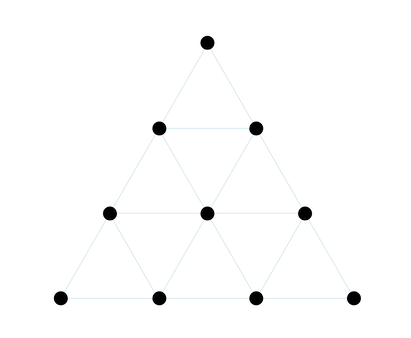
‘One becomes Two, Two becomes Three, and out of the Third
comes the One as the Fourth.’ ~ Pythagoras
In a previous post , we saw how this Cosmology of Pythagoras applies to Tarot. It is but one of the initial or initiatory, key concepts conveyed to us as a visual clue by our Master of Ceremonies, The Juggler/Le Bateleur (aka the Magician). Do you see it?
Hint: It’s ‘dessous la table’, in every Marseille-type deck.

Of course, I am referring to the legs. People tend to write off his three-legged table as simply being of the portable sort that Bagatelles used. It’s true, three legs provide the most stable table for any surface. (Especially if it happens to be a tripod with a Pythia sitting on it). But his table in fact has four. Because one of his legs is behind or combined with one of the table legs, his other leg becomes the 4th leg; ‘the One as the Fourth.’ Another consistent feature is that the rectangular table top always extends beyond the picture border… just how long might it be?
Below are two images of Anubis, god of funerary rites and underworld guide, preparing the dead. His uncovered, lower legs are always visible beneath the embalming bed, and knees about level. This ritual table traditionally had a lion head(s) and legs, which we will return to in a moment.


The Juggler is often equated with Hermes/Thoth, initiator into the mysteries or the ‘in-between’ state itself who oversees the alchemical process. But he’s also seen as an initiate, who maybe doesn’t yet know what all these objects he’s selling are for. As others familiar with Osirian-Orphic mystery content in TdM imagery have noted, they likely allude to dismemberment or sacrifice. They also bear a resemblance to the tools used in the Egyptian ‘Opening of the Mouth’ ceremony, which according to belief, enabled the deceased to eat, breathe, drink and use their senses in the afterlife.

Naturally, the Juggler’s objects also symbolize the four Hermetic elements (ie, the suits of the minor arcana) and the four ways a body is returned to them in traditional funerary rites. The four ‘parts’ of us that are returned to their sources – body to earth, spirit to fire, soul to water, mind or breath to air – will again be drawn from them and remixed, for another round.

Now, let’s just for fun assume the Juggler’s table should have another wooden leg, that it is indeed modelled on an embalming table with leonine features and that it displays tools related to the ‘opening of the mouth.’
Where would we then look for the missing leg? Only the Conver-type decks give us a proper clue [addendum: Dodal also] – the Strength lion’s single leg having a distinctly wooden look and no paw. (Always thought it a rather canine-looking lion). In other TdM decks, it has normal, lion forepaws, which, nevertheless is a hieroglyphic feature, based on Horapollo.

The Pythagorean rule informs us that every 4th card is also a first. 1 was considered masculine/solar and 2, feminine/lunar. 3, while odd, fiery and therefor technically ‘masculine,’ creates the first enclosed space (triangle/womb), so it is actually a combination of masc/fem (the Mercurial, creative magic of the trinity need not be re-explained here). 11 is two 1s or 1+1=2, the lunar partner to the solar Juggler.
I’ll discuss the 2s in my next post, but let the image below, from the Catacombs of Kom El Shokafa, where Egyptian and Greco-Roman mysteries meet, serve as a preview.

The crown/corona worn by royals represents the Sun’s rays. To be coronated means to be crowned with the Sun and become a god-like, solar figure. In alchemy, the Sun symbolizes both the material gold and the hidden, spiritual gold, which is only achieved after a long process. The Juggler holds a little yellow coin or roundel (material gold) and there is a small, yellow flame [aka ear of golden grain] beneath the table, in the distance (spiritual gold). They are separate, at this point in the game.

Notice that every card in the 1/4 place between Juggler and Sun depicts a crown, in various phases of transmutation, as well as solar wheels (Chariot, Fortune) and phallic symbols (all seven do, but in the last card it is a horizontal wall). The Sun is its own corona (unified, risen spirit), but what about the Juggler? He is only a 1, not a 1/4, and wears not a crown but a floppy hat with a spherical, red middle. Could this too be symbolic of the Sun?

Answer is yes. The question of his hat had admittedly irked me a long time, until I saw these beautiful, French prints of Egyptian deities in the NYPL collections.

So the red sphere of the Juggler’s hat represents the solar disk, its brim being vaguely reminiscent of wings – or – perhaps symbolic of the funerary boat in which the Sun god Ra, and thereby Kings and Pharaohs traversed the Duat, when the sun set. The red sphere appears to sink into the brim, ie, setting below the horizon, corona faded. Meanwhile, on the distant horizon flickers that tiny, golden flame of spirit, which will become a bright Sun once again.
Pythagoreans believed in reincarnation, Pythagoras himself was said to have remembered several of his past lives.

On that note, I leave you with a vivid, childhood memory…
My father was a psychiatrist with a sense of humour (and with whom I often played cards). Hanging on our bathroom wall was a small, framed photo of Sigmund Freud, with a quote by Groucho Marx taped beneath:
“This may be a phallus, but gentlemen, let us remember, it is also a cigar.”
~rb
All written content created by and copyright ©Roxanna Bikadoroff and may not be reprinted without permission. Please share via LINK only.





